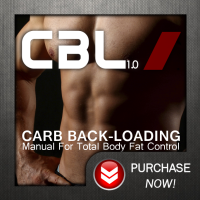Don’t Let Training Derail You
Although this is a book about targeted performance nutrition, the outlined plan relies heavily upon training for its efficacy. I need, therefore, to discuss training—and what qualifies as acceptable. When it comes to Carb Back-Loading, not all training is created equal.
People like to oversimplify, and they like to find random excuses to justify back-loading. This is because they want an excuse to be lazy while still eating everything they love. Did you vacuum the living room today? Well, that’s kind of like resistance training, right? All those reps of pushing and pulling the vacuum cleaner can be rough. This obviously calls for a back-load. Have you walked up and down the stairs of your house several times today? Back-load. Even reading this book, with all the turning of all the pages, or all the mouse-clicking you’ve accomplished, requires a back-load, no?
This may sound asinine, but it’s not far beyond some of the things I’ve actually heard. I once had a stay-at-home mom tell me that she loved back loading, but couldn’t figure out why she was gaining weight. After a few questions, it became clear that she never exercised and barely made it off the couch during the day, but was spending her nights slamming cupcakes, brownies, and ice cream. I think we all know what the problem was there. To her, doing chores, pushing a stroller around the mall, and putting groceries away counted as working out.
I’ve hopefully made it clear that this protocol is for people who train. The type of training you do, however, is just as important. I’ve talked throughout this book about resistance training, so it shouldn’t come as any surprise that Carb Back-Loading isn’t intended for people who engage in endurance training.
Endurance training includes (but isn’t limited to) running, cycling, rowing, cross-country skiing, aerobics, and spin classes. Endurance training a muscle decreases tGLUT concentration, doesn’t translocate tGLUT, and may even impair tGLUT function[1}, thereby forgoing skeletal muscle preference to store glucose—and giving fat cells an opportunity to store it as fat.
NOTE: Neither endurance-type training—i.e., marathon training or CrossFit—nor purely eccentric training (Mike Mentzer’s Heavy Duty) translocate tGLUT. Don’t use either of these types of training exclusively while Carb Back-Loading.
Be aware that some types of endurance training use resistance-assisted movements to increase endurance. Despite the use of a few bumper plates, this type of training is biomechanically and molecularly identical to traditional modes of endurance training.
Recent years have “blessed” us with several of these hybrid, whole-body training programs designed to devastate the energy systems of the body without providing much benefit. Such programs include P90X (and its successor P90X2), Insanity, and CrossFit. Carb Back-Loading, as outlined in this book, is not suited to these training modalities for the same reasons endurance training isn’t. If you want to go with these programs, you’ll require a completely different nutritional protocol, which I’ll address in a future book.
 What’s left are traditional, goal-oriented forms of resistance training: Strength, power, or hypertrophy regimens. Even here, when it comes to back-loading, not all forms of legitimate resistance training work.
What’s left are traditional, goal-oriented forms of resistance training: Strength, power, or hypertrophy regimens. Even here, when it comes to back-loading, not all forms of legitimate resistance training work.
Mike Mentzer’s Heavy Duty training, Dorian Yates’ Blood-and-Guts style, Doggcrapp, and other eccentric-based resistance programs don’t work with this because they fail to translocate tGLUT. Muscular contractions—concentric movement—cause tGLUT translocation[2]. Heavy Duty training, therefore, can’t produce the critical effect necessary to make Carb Back-Loading work as advertised.
I’m not saying eccentric training can’t be used in your training program while you’re Carb Back-Loading. It has many benefits, but the idea is to make it a component of an integrated system (like my Shockwave Protocol), rather than training this way exclusively.
Finally, don’t think a light workout on the selectorized speed circuit at your big-box gym counts, either. The non-insulin mediated translocation of tGLUT depends on training intensity as well as type[4]. Heavy contractions cause the greatest response in tGLUT movement—and the greatest increase in concentration thereof—within skeletal muscle cells.
When you do it right, resistance training and the insulin surge created by your post-training formula will work synergistically to redirect glucose intake away from fat tissue and toward skeletal muscle[5].
Go big, or go home.








Recent Comments